Currently, on view at the Chicago Cultural Center is a mammoth work produced by Susan Giles. This piece, “A Large Reference Corral…” is the culmination of extensive research, adept skill in translating precise details at various sizes, unequalled patience, and an ability to realize a vision that extends beyond one’s periphery. This week the COMP Magazine visited Giles in her Old Town studio to discuss the exhibition Tuned Mass, the relevance of architecture and hand gestures to her aesthetic investigations, her role as an educator, and what she values most in her ongoing practice.
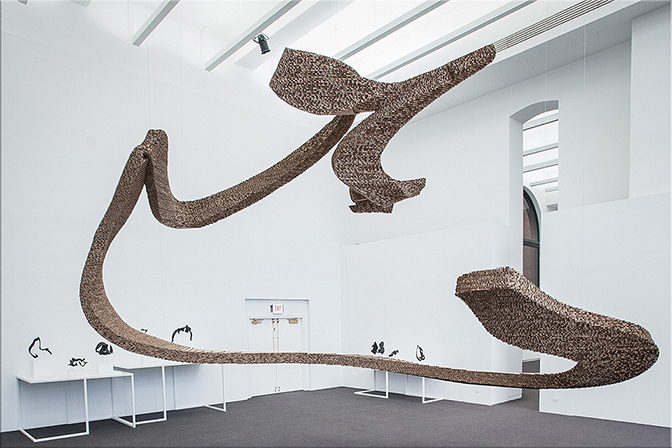
Susan Giles, Tuned Mass, “In the Center There Were Librarians” and Other Gestures, installation view, 2018,
Chicago Cultural Center
You have extensive studies and teaching in the Visual Arts. Currently, you are an Assistant Professor at SAIC teaching in the foundations program. I am interested in seeing if we can step back a bit? Perhaps, you can identify any early experiences or people who you see as prompting this interest?
As a child my mother would take me to art galleries and museums in New York and I clearly remember some of the exhibitions we saw. She was an elementary school teacher, and later administrator, but she was always very interested in art and enjoyed painting and drawing in her free time. In terms of seeing my way to being an artist professionally, my undergraduate sculpture professors were highly influential. They were making large-scale installation work and I had the opportunity to travel with them to install their work in galleries in other states. Their careers seemed so exciting to me. They loved their teaching jobs but had active, successful studio practices as well.
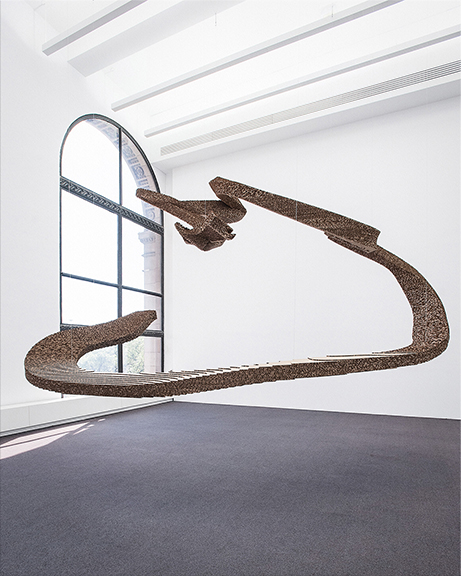
Susan Giles, A Large Reference Corral, Literally Like a Counter, That Went around the Center and in the Center There Were Librarians: Reference Corral (Carolyn), Honeycomb cardboard, 18 x 23 x 16 feet, 2018, Chicago Cultural Center
You are currently producing work for an exhibition at the Chicago Cultural Center. This show is paired with the work of Jeff Carter, your husband, and Faheem Majeed. Do you see any specific connections between your investigations and what the other two artists plan to exhibit?
The curator, Greg Lunceford, has had this grouping in mind for several years, but we have not sat down all together to have a discussion of what everyone is working on, so to some extent I may be surprised. I don’t think the Cultural Center has done three concurrent shows in the Chicago Rooms before. These are three separate, but related solo shows. We all have a relationship to sculpture and the built environment, and we all are responding to a multiplicity of voices in relation to space.
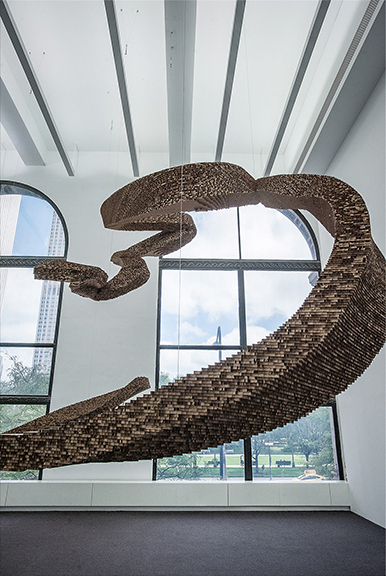
Susan Giles, A Large Reference Corral, Literally Like a Counter, That Went around the Center and in the Center There Were Librarians: Reference Corral (Carolyn), Honeycomb cardboard, 18 x 23 x 16 feet, 2018,
Chicago Cultural Center
Can you walk us through your contribution to the Tuned Mass exhibit? Where did this investigation stem from? What is the intent of this series? Are there any conceptual or technical obstacles?
This show, called “And in the Center There Were Librarians” and Other Gestures, is one in which I have used 3D scanning to capture the gestures people make when describing various architectural elements of the Cultural Center, a landmark building. During the spring of this year, I had an Artist Engagement Residency at the Cultural Center during which time I invited the public to come and talk with me about the building. These recordings include conversations I had with the general public, Cultural Center staff, as well as librarians and archivists who used to work in the building when it was the city’s central library and Grand Army of the Republic hall and memorial. I’m interested in the hand gestures people use to describe this historic building because gestures are important indicators of how we think spatially. They can reveal information about our thinking that is not stated in our speech. Gestures are ephemeral and often operate in the periphery of our awareness. By making the gestures into physical objects for this show, the viewer will be able to spend time with these forms and consider them as remnants of a conversation.
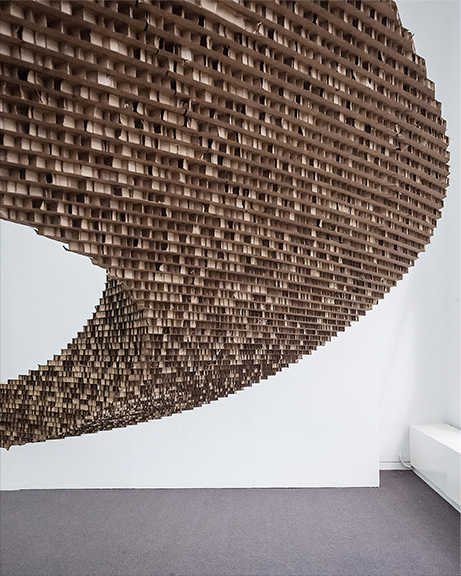
Susan Giles, Detail of: A Large Reference Corral, Literally Like a Counter, That Went around the Center and in the Center There Were Librarians: Reference Corral (Carolyn), Honeycomb cardboard, 18 x 23 x 16 feet, 2018, Chicago Cultural Center
Architecture and place is also relevant when looking at and thinking about your aesthetic practice. Can you share with us your fascination with place and how it functions in ongoing research?
The complexity of the relationship between individual and place only became apparent to me after leaving home in New Jersey. Shortly after moving to Chicago I spent a year in Indonesia on a Fulbright Grant. Whenever people found out I was from Chicago, they would say “Sears Tower!” I began to realize that architecture is a significant part of our identity and the ways in which we represent place. I think about how we represent self and place through anecdotes, social media, and souvenirs. I’ve made models of buildings that I think of as souvenir like because they are inaccurate and reduced in detail. I’ve used video to record people retelling travel stories. The gestures our bodies enact through these narratives reconnect us to past experience by making that experience material for us in the moment of speaking. It’s that material moment that I am seeking to extend in this new body of work.
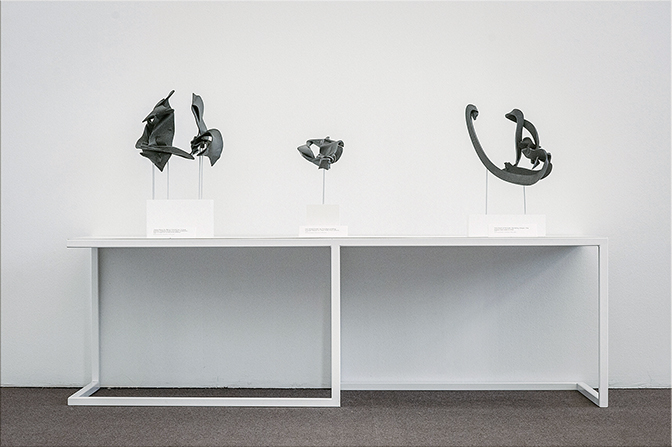
Susan Giles, Installation View, Artworks left to right:
There Were So Many Interesting, Unique Pieces: Objects of the Civil War Collection, Part of Special Collections (Kathy.),
3D Printed PLA plastic, aluminum, MDF, paint, 16 x 15 x 10 inches, 2018
Top of the Dome, so You Are Locating Yourself Based on That: Fifth Floor (Zhon), 3D Printed PLA plastic, aluminum, MDF, paint, 6 x 7 x 16 inches, 2018
This Kind of Smooth, Spiraling Shape: The Grand Staircase (Cindy), 3D Printed PLA plastic, aluminum, MDF, paint,
13 x 20 x 10 inches, 2018, Chicago Cultural Center
As previously noted you teach. Are there any specific ideas or items that you see that you regularly share with your students?
A recurring theme in my classroom is material history. I show students the work of artists such as Cornelia Parker and Teresa Margolles among others. These artists carefully select materials that convey information about history, place, and the stories of people.
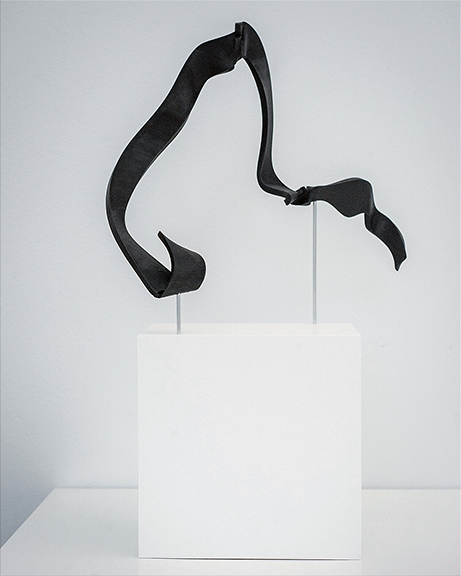
Susan Giles, And It Will Carry All the Way to the Other Side: Whisper Chambers (Tim J.), 3D Printed PLA plastic, aluminum, MDF, paint, 16 x 20 x 10 inches, 2018, Chicago Cultural Center
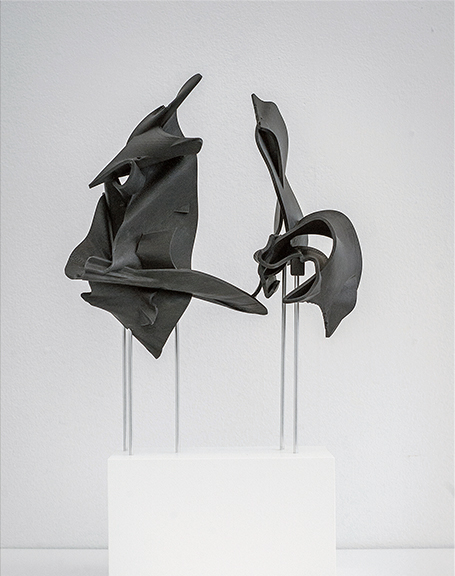
Susan Giles, There Were So Many Interesting, Unique Pieces: Objects of the Civil War Collection, Part of Special Collections (Kathy.), 3D Printed PLA plastic, aluminum, MDF, paint, 16 x 15 x 10 inches, 2018, Chicago Cultural Center
What do you value most in your artistic practice?
What I value most in my practice is the ability to learn and explore new ways of working. I’ve recently learned new technologies, such as laser-cutting, 3D motion capture, and 3D printing. I love to be challenged in the studio and try new materials. The sculptures in this show at the Cultural Center involved much trial and error over the past two years. I had the pleasure of working with artist Lindsey french to get me started on the technology. I then worked with a wonderful recent graduate of SAIC, Amo Zeng, who helped figure out the multiple softwares and workflow to get the kinds of 3D models I was seeking. The result is that the gestures in this show are a direct digital trace of someone’s gesture made into a physically tangible form to share with the viewer. They are like artifacts of a conversation left behind; a kind of material evidence of their thinking.
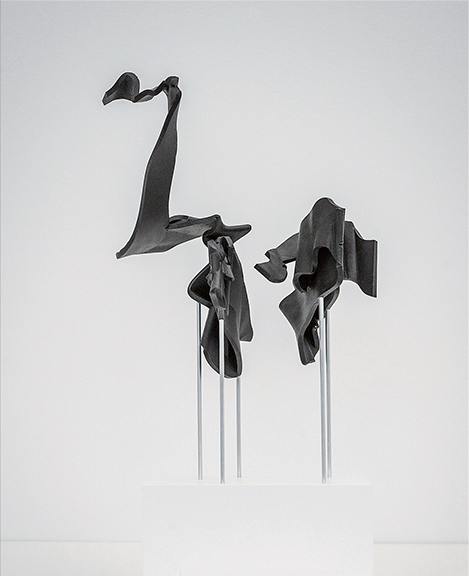
Susan Giles, Metal Bookcases in Multi-Level Tiers That Had Glass Floors so You Go in These Spaces That Were Just This Little Corridor and a Little Light Bulb in the Ceiling: Stacks (Tim S), 3D Printed PLA plastic, aluminum, MDF, paint, 22 x 19 x 9 inches, 2018, Chicago Cultural Center
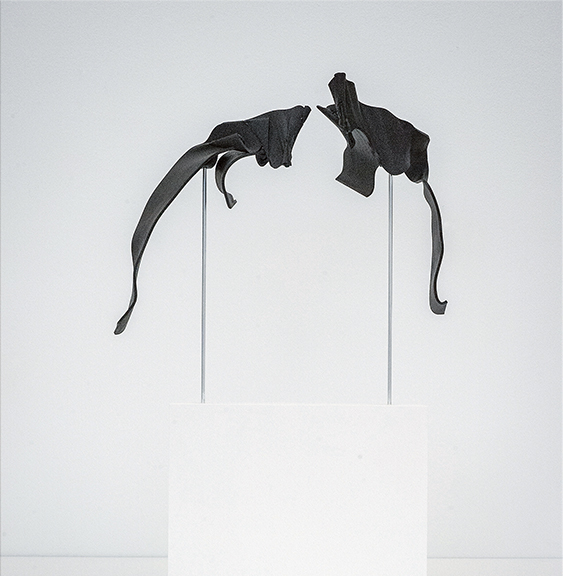
Susan Giles, Circles That Get Smaller in on Themselves: The Tiffany Dome (Rachel), 3D Printed PLA plastic, aluminum, MDF, paint, 19 x 18 x 5 inches, 2018, Chicago Cultural Center
With the exhibition at the Cultural Center up, what’s the plan from here? Do you have any new work in progress? What is the plan for the remainder of 2018 and onward?
I’m looking forward a couple upcoming collaborations. In the spring I’ll be working with Manchester-based artist Sally Morfill in a three-month residency at the Hyde Park Art Center. Sally has worked with gestures in her practice as well. Sally and I will present work at HPAC, then travel to produce and show work in an artist-run gallery in London called Five Years Gallery. I’m also working on an interdisciplinary collaboration with Cristina Garduño Freeman, a scholar in the fields of heritage, architecture and digital media at the Melbourne School of Design.
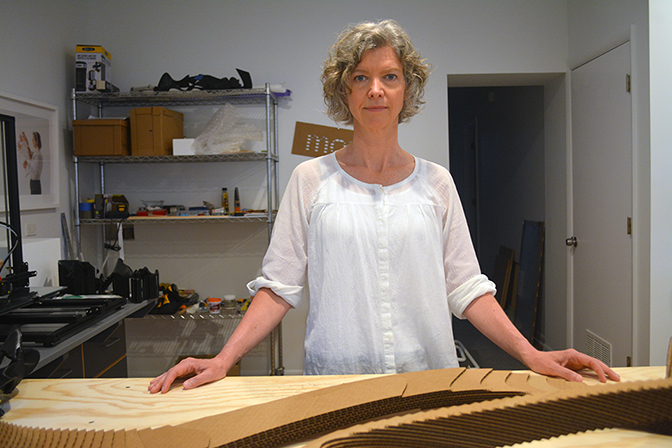
Susan Giles, artist, in her Old Town studio, Chicago, 2018
For additional information on the aesthetic practice of Susan Giles, please visit:
Susan Giles – http://susangiles.net/
Mana Contemporary – http://www.manacontemporarychicago.com/susan-giles/
The Mission Projects – https://themissionprojects.com/artist/susangiles
Hyde Park Art Center – http://www.hydeparkart.org/exhibition-archive/susan-giles-scenic-overlook/
Chicago Artist Writers – https://chicagoartistwriters.com/interior-monuments-an-interview-with-susan-giles/
All installation photographs are courtesy of Kip Wilkinson.
Artist interview and portrait by Chester Alamo-Costello.


